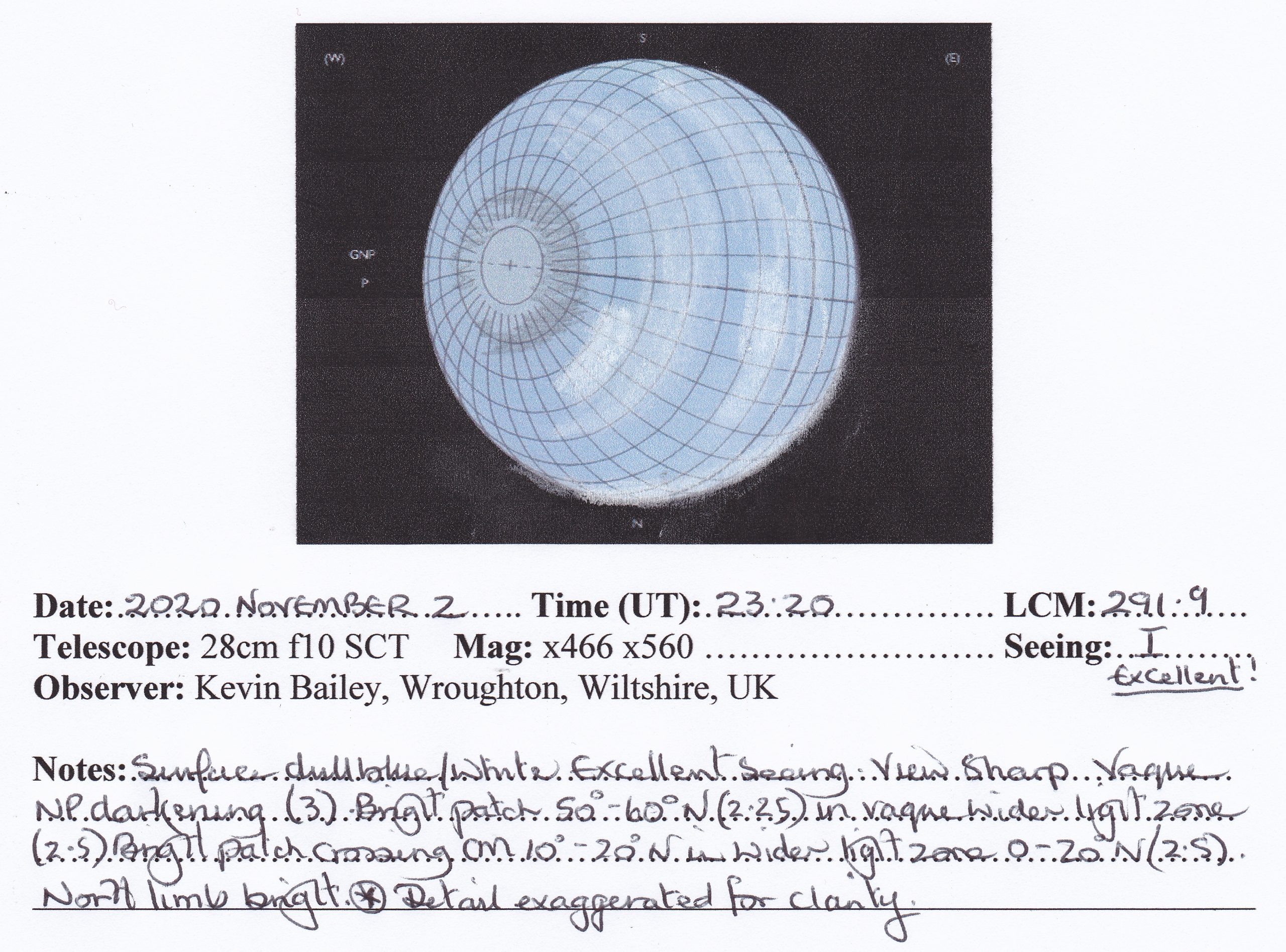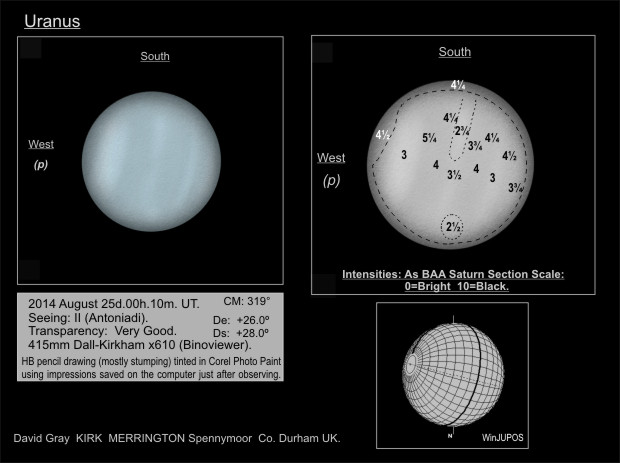Uranus: ‘a rose by any other name…’
2022 August 7
Uranus (Yew-ran-us – no smirking at the back…) has endured a 200-year-old PR problem; its name, which (in English) has generated much low humour and comic double entendres (as anyone giving a talk to teenagers on the subject can testify). I am sure the reputation of this enchanting planet would have been enhanced with the application of a little gender equality: ‘Minerva’ (for example) would have been a more suitable name – she being the goddess of wisdom; the equal of Jupiter, and celebrated by a Roman festival in March (as ‘Sulis Minerva’) at Bath, where Uranus was discovered. But the dull name stuck, and as a consequence ‘Uranus’ has never acquired the attractive associations we tend to make with the names of the other major planets. This may seem a trivial point, but is possibly one of many reasons for the relative neglect of the planet as a subject for research and observation.
Uranus has always had its advocates, but study of it has been something of a professional backwater, and its neglect by amateurs has in no small measure been the result of prejudice on the part of the authors of popular astronomy books. To quote two writers I hold in high regard, J. B. Sidgwick and Sir Patrick Moore, ‘[Uranus] offers no scope for amateur work…’ (Observational Astronomy for Amateurs, Sidgwick), and ‘Even large telescopes will show virtually nothing on Uranus’ pale disk … Uranus is a very bland world’ (New Guide to the Planets, Moore). Any of us who came to astronomy over the last 50 years will be familiar with the couple of pages devoted to Uranus at the back of otherwise useful astronomy books. Even space probes, generally opening up greater understanding and interest in their assigned subjects, have ignored Uranus – except for Voyager 2, beaming back those ‘bland’ images as it sped past in 1986, adding yet another negative to the planet’s reputation.
But things change, and a small number of devoted amateur observers are proving that Uranus is very far from being a bland planet. This is demonstrated by the growing number of articles and reports relating to Uranus published in the Journal over the last few years. Uranus now represents a final frontier for visual and digital planetary observers – and, while ‘the professionals’ have time-limited access to the world’s largest telescopes (from which they derive highly detailed data), amateurs are increasingly making a complementary contribution by observing and recording Uranus over whole apparitions, which, in time, will add to a more general understanding of the planet’s nature.
If I have tempted you to observe Uranus, here are a few notes that I hope will get you started.

Locating
Uranus reaches opposition on 2022 Nov 9 (magnitude 5.6, diameter 3.8 arcseconds). It can be easily found using the coordinates published in the BAA Handbook, with reference to Norton’s Star Atlas – or digital programs such as Stellarium – and then sweeping for the small blue disc in the traditional way. Even with a relatively low-power eyepiece, Uranus will appear distinctly ‘planetary’. Of course, a GoTo mount will do the job for you.
Observing
Uranus is at present (in the northern hemisphere) the best-placed major planet in the night sky, but it is far from being an easy observational subject. It took me four years to ‘get my eye in’ regarding the disc ‘detail’. It helps to make as many observations as possible over an apparition. Some keen-eyed and experienced observers have recorded detail on Uranus’ disc using 152mm instruments – but these are exceptions, and I would say that a 215mm-aperture instrument is the minimum adequate size.
As always, light and magnification are the essential factors, and to get a bright decent-sized disc in the eyepiece requires ×400+ magnification and a telescope that can take such a power. Using my 28cm ƒ/10 Schmidt–Cassegrain telescope, I get the best results using a magnification of ×466 and ×560 – and I only make observations when the seeing is I or II on the Antoniadi scale (I = excellent; V = very poor).
At the beginning of an observation, make sure you have got the orientation of the planet fixed. With the drive off (or temporarily impeded using light finger pressure on the tube), the preceding (p.) edge of the planet will drift out of the field of view. Bearing in mind that the N/S axis of Uranus is effectively horizontal, this will indicate the location of the planet’s north pole, which is at present near to the centre of the p. edge – i.e., the one leading out of the field of view. (See Figures 1 & 2.) By 2028, the north pole will have moved to the centre of the planet’s disc.
Recording
For recording, I use a coloured 2-inch (50mm) disc with latitude and longitude lines derived from WinJUPOS at the start of each apparition. I use white chalk to depict lighter features and a soft dark pencil for the darker areas (as shown in Figure 1.)
David Gray, probably the BAA’s most experienced visual observer of Uranus, makes a comprehensive record of each observation, including a drawing, intensity estimates (using the ‘Saturn scale’), and other useful data. Figure 2 shows one of his observations from 2014.

Reading
The Planet Uranus by A. F. O’D. Alexander provides the best history of the planet, and Uranus, Neptune, and Pluto, by Richard Schmude Jr., is the most up-to-date publication regarding observing advice and information. You will find any of the reports and articles on Uranus published in this Journal useful.
********
If you haven not observed Uranus before, then I encourage you to give it a go. For anyone who likes a challenge, it is the perfect subject – and that little blue disc is very enchanting. All you need is a dark-adapted eye, a pencil and paper, and a lot of patience… and do not forget to send in your observations regularly to the Saturn, Uranus & Neptune Section.
Kevin Bailey, Uranus Coordinator, Saturn, Uranus & Neptune Section
| The British Astronomical Association supports amateur astronomers around the UK and the rest of the world. Find out more about the BAA or join us. |
